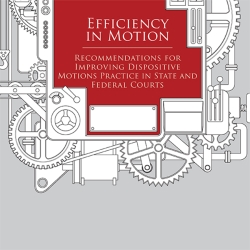Judges Are Implementing IAALS' Dispositive Motions Recommendations
 In January 2019, IAALS published Efficiency in Motion: Recommendations for Improving Dispositive Motions Practice in State and Federal Courts, calling for a new paradigm for motion practice in the United States. The recommendations are more than just a collection of best practices; they are truly a call for action to the bench and bar to actively engage in improving current motions practice with the goal of better outcomes for all involved. Judges around the country are answering the call by putting these recommendations in place in their practice standards.
In January 2019, IAALS published Efficiency in Motion: Recommendations for Improving Dispositive Motions Practice in State and Federal Courts, calling for a new paradigm for motion practice in the United States. The recommendations are more than just a collection of best practices; they are truly a call for action to the bench and bar to actively engage in improving current motions practice with the goal of better outcomes for all involved. Judges around the country are answering the call by putting these recommendations in place in their practice standards.
IAALS Calls for a New Paradigm in Motion Practice
Litigators use a variety of tools and strategies to advocate for their clients during a lawsuit’s life cycle. While resolution by a trial verdict is revered, lawyers often seize the opportunity to dispose of all or part of a lawsuit using dispositive motions. The most common dispositive motions are motions to dismiss for failure to state a claim and motions for summary judgment. When used appropriately, these motions can make civil litigation more efficient, saving the court and the litigants time and money. But when they are filed reflexively and are not thoughtfully managed or timely ruled upon by the court, they inject additional cost and delay into court systems across the country, ultimately undermining access to justice for all, from individuals to large companies.
Judges and attorneys from across the country point to dispositive motions practice as a vital area for reform. Indeed, motions practice—as much as discovery—has a critical role to play in civil justice reform. So, starting in 2017, IAALS undertook an in-depth evidence-based analysis to determine challenges in motions practice and to figure out how to make civil motions practice more efficient.
In May 2018, IAALS published an empirical study of summary judgment in 10 U.S. District Courts, Efficiency in Motion: Summary Judgment in the U.S. District Courts, which found that across the diverse sample of federal district courts, there is a statistically significant difference in terms of filing rate, length of motions and opinions, time to disposition, and time to ruling.
IAALS’ research served as a foundation for additional study into areas for reform identified by national experts and a broad base of stakeholders with different perspectives and experiences. In tandem with the docket study, IAALS hosted a convening of judges, attorneys, and scholars from around the country, focused on the challenges of dispositive motions practice and identifying best practices. IAALS then created a smaller Working Group to dive deeper and to create recommendations for improving motions practice, informed further by a survey we conducted of the American College of Trial Lawyers (ACTL) state committees.
In January 2019, IAALS’ ultimate recommendations for improving dispositive motions practice were published. Five animating principles are intended to guide reform by the bench and bar:
- Principle 1: “One size does not fit all.” The dispositive motions process must be right-sized and tailored to the needs of the case.
- Principle 2: Motions are part of the whole case and should not be addressed in a vacuum.
- Principle 3: Courts should rule promptly on dispositive motions.
- Principle 4: Summary judgment motions are not appropriate for all cases.
- Principle 5: Cooperation and communication between counsel is critical to the speedy, effective, and inexpensive resolution of dispositive motions.
The recommendations are more than just a collection of best practices. They are truly a call for action for judges, courts, and lawyers to actively engage in improving current motions practice with the goal of better outcomes for all involved.
Judges Are Answering the Call
Effective December 1, 2019, Judge R. Brooke Jackson of the U.S. District Court for the District of Colorado revised his practice standards to address motions to dismiss and motions for summary judgment based on IAALS’ recommendations. Before filing a motion to dismiss, Judge Jackson requires counsel for all parties to have a substantive meaningful conversation to discuss:
- The issues that the movant intends to raise in the motion to dismiss;
- Whether the parties could resolve all or some of those issues without a motion;
- The reasons that the movant believes those issues are legally meritorious;
- The reasons that the non-movant believes the motion should be denied;
- Whether there are any alternatives to the motion that would suffice (for example, could the plaintiff simply amend the complaint?); and
- Whether the motion could be resolved through a streamlined process (for example, letters instead of briefs, or in a conference with the court).
If there are still unresolved issues, Judge Jackson then obligates counsel on both sides to each submit a short letter to determine next steps.
Regarding motions for summary judgment, Judge Jackson requires counsel to submit a short letter to the court as to why summary judgment is appropriate, so that he may make suggestions on the issues and responses.
Also effective December 1, 2019, Judge William J. Martinez of the U.S. District Court for the District of Colorado revised his practice standards as well, to address motions to dismiss and motions for summary judgment, among other matters, acknowledging that “the overuse of Rule 12 motions unreasonably delay the progress of civil litigation.” Judge Martinez enforces the importance of counsels’ requirement to meaningfully confer before filing motions to dismiss by placing all attorneys on notice that a violation of his practice standard may result in an award of attorney’s fees and costs assessed personally against them. Judge Martinez sets specific requirements if counsel files motions for summary judgment and notes specifically that “[c]ounsel are well-advised to avoid reflexively filing a motion for summary judgment.”
The Court Procedures of Judge George C. Hanks, Jr., of the U.S. District Court for the District of Southern Texas require pre-motion conferences before filing a motion to dismiss or a motion for summary judgment. To request a pre-motion conference, Judge Hanks requires counsel to file and serve a short letter, no more than three pages, stating the basis for the anticipated motion and that they have conferred with all parties. Judge Hanks may act on the initial letter, may set a pre-motion conference, or may determine that a pre-motion conference will not be a “useful expenditure of the parties’ time . . . .”
Similarly, the Pretrial Preferences of Senior Judge Janet Bond Arterton of the U.S. District Court for the District of Connecticut do not permit dispositive motions until there has been a pre-filing conference. For summary judgment motions, Judge Arterton “uses the pre-filing conference to determine whether the case is appropriate for mediation before resources are expended on briefing” and finds that having a pre-filing conference discourages questionable summary judgment motions.
These practice standards highlight the positive steps judges are taking around the country improve motions practice and to save litigants both time and money.



